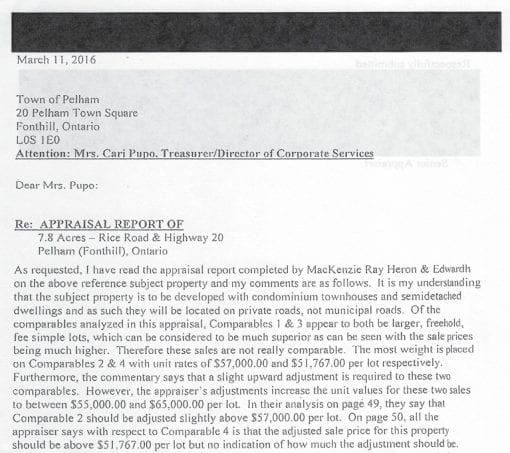How did three acres “in the middle of nowhere,” by one developer’s assessment, get transformed into some of the most valuable empty real estate in the history of Niagara? By telling a good story, says a commercial real estate appraiser.
Agreeing to speak off the record (a number of other Niagara appraisers declined to talk on any condition), a senior appraiser we’ll call Smith, with nearly three decades’ experience in Niagara and beyond, says that inflated valuations aren’t unusual, but he’s never heard of a number matching $928,000 per acre in Niagara for unserviced land minus even an access road.
“Hello? Are they trying to build Disneyland?”
In March 2014 the Town of Pelham negotiated a comprehensive land deal with Fonthill Gardens, a subsidiary of the Allen Group, a GTA commercial development company. (The new Fonthill Marketplace, anchored by Food Basics, is an Allen project.)
In September 2015 an additional agreement was reached between the parties calling for the swap of development charges credits in lieu of cash for acreage that the Town sought to acquire. The agreement specified that the value of the acreage was to be determined by the seller, the Allen Group, based on an appraisal that they themselves would commission.
Appraisers are chosen to estimate “market value,” says Smith. “It’s up to the seller and buyer to establish ‘actual value’ by acting ‘prudently.’”
If a high appraisal is the goal, he says, “Sometimes appraisers are fed the Kool-Aid and they drink it.”
The resulting appraisal for the East Fonthill land, prepared by the Toronto firm of MacKenzie, Ray, Heron & Edwarth (MRHE), concluded that approximately eight acres situated between Highway 20 and Port Robinson Road were worth a bit over $1.1 million dollars each as of November 2015. Some 148 building lots were projected for the acreage.
This figure was “peer-reviewed,” or double-checked, by a second appraiser, who concluded in March 2016 that the $1.1 million figure was high, but not by much. The peer reviewer reduced the per-lot value from an average of $60,135 each to $54,000 each. The eventual price was settled at approximately $928,000 per acre.
Yet with adjacent and nearby lots selling for $152,000 per acre as recently as last autumn, how did these eight acres come to be valued five times higher back in 2015?
The appraisal employed a method known as an “extraordinary assumption” to get its math to add up.
Extraordinary assumptions are not uncommon, says Smith, but must be grounded in reality. Smith says that he’s sometimes called on as an expert witness by malpractice insurers defending appraisers sued for miscalculations, but that some errors are so egregious that he can’t in good conscience take the assignments.
(Neither Smith, nor the Voice, has seen evidence that an intentional attempt to mislead was present in preparing the appraisal at issue, nor is there an assertion that any breach of professional ethics, or the law, occurred.)
It’s not uncommon, says Smith, to “bury facts” or “bury assumptions” in an appraisal, a document that can run anywhere between a few dozen to a few hundred pages. (The MRHE appraisal is 57 pages.)
“The average person—even an OMB judge—doesn’t have the attention span. The longer the appraisal, the easier it is to mislead the reader,” says Smith. Will the reader be able to recognize a buried fact, “or are you being taken down a path.”
The extraordinary assumption used in the East Fonthill appraisal was that all eight acres of land, rather than being empty, were instead assumed to be 148 “fully serviced lots,” building lots that have already been supplied with hydro, natural gas, water, sewer, sidewalks, and paved roads, entirely ready for builders to start pouring foundations and commence home construction.
Two cautionary footnotes appear in the appraisal, one at the start, one at the end, defining the term. Both read, “Extraordinary Assumption: an assumption, directly related to a specific assignment, which, if found to be false, could alter the appraiser’s opinions or conclusions. Extraordinary Assumptions (Hypothetical Conditions) presume as fact simulated but untrue information about physical, legal, or economic characteristics of the Subject property or external conditions.” (Our emphasis.)

Appraiser Smith, who says that he has worked on appraisals and as an appraisal consultant across North America, including for all levels of Canadian government and the US federal government—as well as in Pelham in the East Fonthill project itself—asserts that an appraisal is like a story, and that if a reader doesn’t understand the story it’s up to the appraiser to rewrite it until it makes sense. If it can’t be made to make sense, then the underlying premises may be faulty.
In this case, it appears that the story was written well enough to be understood by CAO Darren Ottaway, Mayor Augustyn, and Pelham Town Councillors, who ultimately okayed the deal.
The appraisal’s original author has not responded to requests for comment.
The peer-reviewer’s name and firm’s name were redacted, at their request, from the appraisal copy the Town eventually provided to the Voice after multiple inquiries.
On this and related stories, neither Planning Director Barb Wiens nor former Senior Planner Julie Hannah have responded to requests for comment.
David Allen, principal with the Allen Group, has not responded to requests for comment.
Pelham CAO Darren Ottaway has not responded to a request for comment.
No Pelham Town Councillor has responded to requests for comment.
For an extended interview with Hummel relating to East Fonthill, see THE CONVERSATION: A whistleblower blows: http://www.thevoiceofpelham.ca/whistleblower



